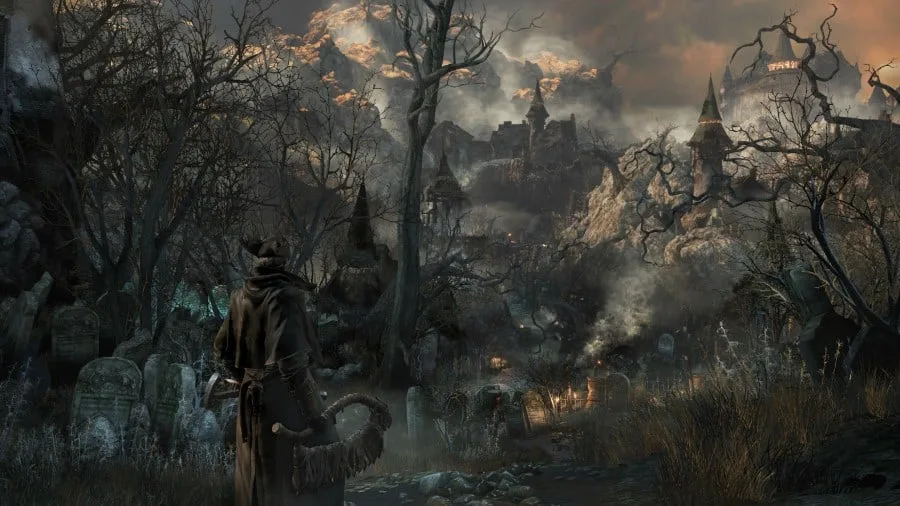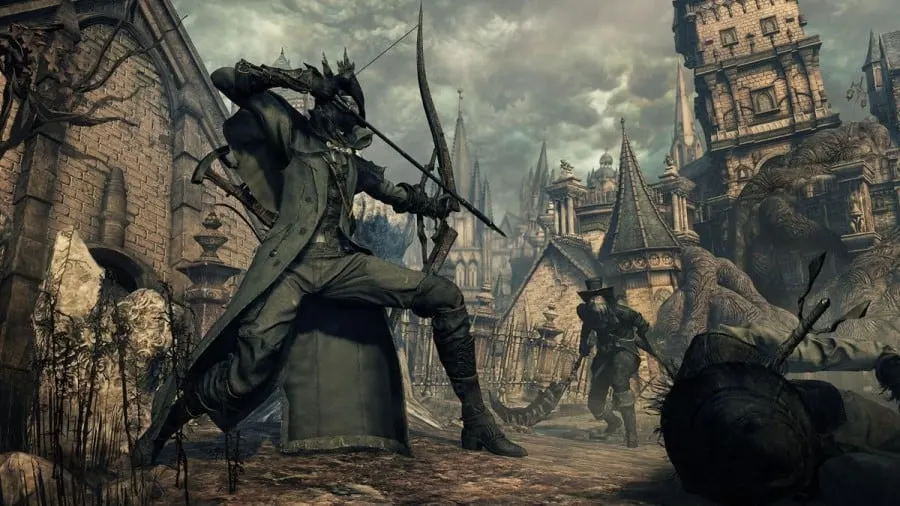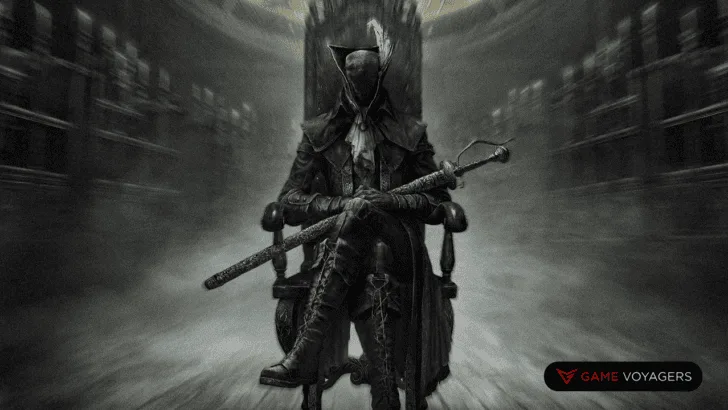“We are born of the blood, made men by the blood, undone by the blood. Our eyes are yet to open. Fear the Old Blood”.
These are words that you need to very much take to heart when you start playing Bloodborne. While it’s one of the most rewarding games you’ll ever play, it is also one of the most difficult.
You need to prepare yourself to die. A lot. You will rage, you will probably cry, but the satisfaction that you feel when you finally slay your first, and last, the beast will make all of the pain worth it.
Beginner Bloodborne Tips and Tricks – Combat

Like any Souls game, combat is the cornerstone of gameplay. For those with no interest in the world or lore, the combat is the entire Bloodborne experience.
Learn your enemies
The first and most important tip that we have for you new players is to learn. You are not some superhero pulled from an epic fantasy of yore. You are a hunter, and you are not special. At least, not yet.
Every enemy around every corner has the potential to kill you in a split second, and trust us when we say you’ll get to experience this first-hand if you haven’t already.
However, your enemies are also predictable. Each foe has a particular move set, and that move set does not change. What this means is that you can learn how to fight each enemy by understanding when in their combo you need to dodge, and when you can attack.
When you first encounter a new foe on your hunt, spend some time studying them. Draw their aggro then take a step back. Practice baiting them into a combo and then dodge away. Doing this is going to allow you to see how many swings they have before they need to rest, and the timing for those attacks
Some enemies are faster than others, some are slower and swing at you with a clobbering yet plodding pace. You need to learn the fundamentals of each attacking style, as well as how to fight against them.
At the beginning of the game, make sure you don’t over-commit yourself to your attacks. Bait out a combo, watch the combo and wait for it to finish. After that, dodge back in for a hit or two, baiting out another combo and repeating the process.
Eventually, you will build up the skill, knowledge, and confidence to get your hits in between the swings in your enemy’s combos, making the experience much more fun and seamless. Speaking of confidence….
You HAVE to play aggressively
Okay, this contradicts the tip that we just gave you, but hear us out. While learning how your enemies fight is one of the keys to victory on the streets of Yharnam, the methodology changes with the boss fights.
The Bloodborne boss fights are likely the reason you’re picking up the game to begin with. However, these bosses play very differently to the others in the Souls series.
Once you have a basic idea of how a boss attacks, you need to get down and dirty with them. Going in for a cheeky swipe and then backing off is going to get you killed. There is no way around that.
To punch home the fact that you have to be aggressive, a lot of the bosses in the game can be staggered by attacking their legs with chained transformation attacks (your trigger attacks that change your weapon mode.)
The bosses that can’t be staggered can be parried (shoot the boss just before they attack to parry them. You can then walk up to them and attack to deal a visceral attack for massive damage.)
Generally, parrying is only able to be used on beasts and humanoids, so don’t go trying to shoot Sister Amelia with the hopes of stopping her from ripping you in two.
On top of that, be prepared to dodge INTO attacks. While our brain tries to tell us the opposite during combat, dodging out of the way of enemy attacks is going to get you slaughtered. When you notice a swing coming at you, dodge into the direction that it’s coming from. Disregarding any kind of invincibility frames, you’re going to go under the swing, putting you in a position to land a hit or two of your own.
For the big guys, you need to be able to dance with them. Attack, dodge, attack, attack, wait for a second to regen stamina, dodge, attack, attack, end of a boss fight. You’re not going to be getting a breather.
While this doesn’t apply to all bosses in the game, (The Witches of Hemwick don’t play like this,) it is a general rule of thumb. Don’t be surprised if the faster paced boss fights in the game don’t last more than a minute or two.
Stamina management
Everything you do in Bloodborne costs stamina. From attacking, dodging, rolling, jumping, every action is going to tire you out.
At the beginning, not managing your stamina is going to be the thing that gets you killed the most.
It’s a difficult balancing act. You have to fight the bosses aggressively, but you can’t just go in hacking and slashing. There is a particular method to the madness.
Keep an eye on that stamina bar and pace it out with what you know about your enemies. If you know the boss stops for a second after a combo, don’t be afraid to deplete the bar getting an extra hit in, but always let it regen before the process starts again.
Pay attention to the learning curve
For most hunters, the very first mandatory boss; Father Gascoigne, is the hardest boss in the game. He exemplifies the aggressive, fast-paced playstyle that you’re going to have to adjust to.
Once you finally beat him, though, you’re going to notice that your skill gets progressively better. The entire game is a learning curve, and once you adjust yourself to the Bloodborne style of combat, you’re going to have a much easier time of things.
The hunter’s best friend
A hunter’s best friend in the streets of Yharnam is his weapon. Also known as trick weapons, these devices were made specifically to assist them in their hunts against the beasts.
Being blunt, the best weapon that you can pick up for your first playthrough is the saw cleaver that you get at the beginning of the game, the first time you enter the Hunter’s Dream.
If you picked a different weapon, you can still buy it from the messenger fountain. It isn’t the best weapon in the game, but it is perfect for beginners looking to get to grips with the world.
Learn your weapons attacks
Just like you need to learn how your enemies attack, you need to learn how you attack.
Your weapon has two modes, each with different sets of combos. Learning the ins and outs of these combos is absolutely critical to your success on the hunt.
It’s not just the timing that you need to learn, either. You need to recognize hit boxes and stamina drain, too.
You’re going to be spending a lot of time with your weapon of choice, so you should learn this naturally as you progress, but remember to pay attention to it.
Lookout for blood gems
As you progress on your hunt, you’re going to stumble across blood gems. These blood gems can be used to upgrade your weapon in the workshop in the Hunter’s Dream. As you go on, enemies get tougher, so you want to make sure that you keep your weapon scaled with them.
The types of blood gems that you need to upgrade change as you progress and level up your weapon. If you keep on pace, the type that you need is going to be found in the area that you are currently fighting through.
Stock up on consumables
Fire paper, blood cocktails, blood vials. Learn the names of these items and learn them well.
Fire paper can be put on your weapon to increase your damage against beasts, while blood cocktails can distract the blood craved monsters. Both of these can be looted around the world or bought from the messengers at the fountain.
However, what you really want to keep a stock of are blood vials. Blood vials are your healing item, and you are going to be using a LOT of them at the beginning of the game.
You can keep 20 of them on you at once, with any others being kept in storage in the Hunter’s Dream. When you return to the dream, your stock is replenished. You’re going to want to do this at every single lantern that you light.
Trust us when we say that you can easily burn through all 20 of these in one boss fight. Like other consumables, you can buy these at the fountain. If you ever have some blood echoes to spare, pour them all into blood vials.
About insight
Aside from blood echoes, the other currency in the game is insight. You gain insight from consuming Madman’s Knowledge, seeing a boss for the first time, or defeating one.
As a rule of thumb, the more insight you have the harder the game becomes. It represents your connection to the great ones, and as it increases so too does your perception of the world. Things become more nightmarish, and some enemies take on entirely new forms.
You can spend insight on consumables in the Hunter’s Dream, although you don’t need to worry about this until later on in the game.
Enemies Respawn
Going to Hunter’s Dream every chance you get is important to replenish blood vials. However, to balance this out it also causes all the enemies in the world to respawn. So don’t be surprised if you return to Yharnam only to find that the ogre you spent 10 minutes getting your ass kicked by has popped back up.
Beginner Bloodborne Tips and Tricks – Levelling

Levelling in Bloodborne works differently to other conventional games that you may have played.
How to level up in Bloodborne
You level up using blood echoes. You get these echoes from consumable coldbloods, or from defeating enemies around Yharnam. You use blood echoes for both levelling up and for buying consumables, so you need to balance out how you spend them.
When you have enough echoes to level up, you need to speak with the Doll in the Hunter’s Dream. When you interact with her, click on “channel blood echoes,” and you can level up by assigning points into one of your various attributes in exchange for a scaling amount of blood echoes.
For each level, you get one point that you can put into one of your skills.
About blood echoes
Remember that when you die you drop all of your blood echoes. You have one chance to get these back before they are gone for good. So don’t be afraid to spend your echoes liberally.
Bloodborne attributes
You have six primary attributes that you need to be aware of:
Strength: Strength governs your physical weapon attack damage, as well as the damage of your visceral attacks. Strength based trick weapons benefit from this skill more than other weapon types.
Skill: Skill governs more nuanced physical weapon attack damage, as well as visceral damage. Your skill level also determines what weapons you can use. Skill based weapons get a higher attack bonus the higher your skill level is. It serves as a mirror to strength.
Bloodtinge: Your bloodtinge level determines the strength of weapons that deal blood damage, such as the Chikage and Bloodletter, as well as the majority of firearms. Some blood damage weapons cannot be used if you are below a certain bloodtinge level. This skill is more specialized, and not very beginner friendly.
Arcane: Your arcane skill determines the damage you do with arcane attacks, and also influences your ability to use certain weapons. It also affects your discovery, or drop, rates.
Vitality: Your vitality is your HP. The higher the skill, the more health you have. This is one of the most vital skills for a beginner player to invest in.
Endurance: Your endurance skill manages your stamina bar and resistance to certain damage types. This is widely considered to be the worst attribute in the game, so don’t invest in it too heavily.
The best beginner build in Bloodborne
While you can build your character any way you want, the most beginner friendly build is a high vitality quality build. This is when you level up your vitality, as well as investing equally in strength and skill.
This build is going to give you good damage output with most weapons and, more importantly, the ability to use most of the weapons in the game. You can then experiment with different trick weapons to see what you prefer and build especially around that in your next playthrough.
Soft and hard caps in Bloodborne
This is more sophisticated knowledge but we’re going to bring it up briefly. While different skills have different caps, at the beginning you should operate around a 25-40 rule.
At level 25, you’re going to reach the first soft cap. From here you see diminishing returns on your investment, but it is still worth levelling. At 40, you hit a harder soft cap, at which point it isn’t really worth investing in that skill anymore.
The hard cap for skills is 99, but there is no point in levelling a skill to that point.
A note on blood level
Blood level, or BL, refers to the overall level of your character. Don’t worry about it now, but when you’re more experienced it becomes important. Many builds you find online are for a specific blood level, meaning you only have so many points to work with.
PvP, for those that are interested, also revolves around various BL metas.
Beginner Bloodborne Tips and Tricks – Exploration

We’re only going to talk about this briefly. The level design in Bloodborne is, for the most part, very linear. While there are times that are going to require you to figure out where you’re going, if you go straight and progress through each part of the game normally, you’re going to get where you need to go.
Despite being open world. Each area operates almost like an on-rails game. Simply move forward, and you should reach the boss.
There are two areas in the game that you can miss, though. We won’t spoil it here, but if that’s something that worries you, you can look them up yourself.
Conclusion
Hopefully, you’ve found our Bloodborne beginner tips and tricks helpful. We’ve collected only the nuggets of knowledge that we believe are the most important for fledgling hunters to know, so don’t stress out if there is some piece of technical information that we didn’t cover here.
Focus on getting better at the game before you dive into any sort of theory, otherwise you’re going to be trying for techy moves when you don’t even have the fundamentals down.
The world of Bloodborne is rich in lore and style, so take your time, fight hard, and remember to enjoy yourself, good hunter.

